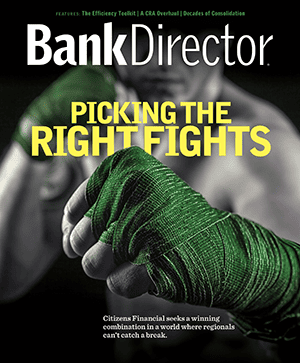
Three Tech Questions Every Community Bank Needs to Ask
Brought to you by FIS

Community banks know they need to
innovate, and that financial technology companies want to help. They also know
that not all fintechs are the partners they claim to be.
Digitization and consolidation have
reshaped the banking landscape. Smaller banks need to innovate: Over 70% of
banking interactions are now digital, people of all ages are banking on their
mobile devices and newer innovations like P2P payments are becoming
commonplace. But not all innovations and technologies are perceived as valuable
to a customer, and not all fintechs are great partners.
Community banks must be selective when investing their limited resources, distinguishing between truly transformative technologies and buzzy fads.
As the executive vice president of
digital and banking solutions for a company that’s been working closely with
community banks for more than 50 years, I always implore bankers to start by
asking three fundamental questions when it comes to investing in new
innovations.
Does the innovation solve problems?
True innovation – innovation that changes people’s financial lives – happens when tech companies and banks work together to solve pain points experienced by banks and their customers every single day. It happens in places like the FIS Fintech Accelerator, where we put founders at the beginning of their startup’s journey in a room with community bank CTOs, so they can explain what they’re trying to solve and how they plan to do it.
Community banks don’t have the luxury
of investing in innovations that aren’t proven and don’t address legitimate
customer pain points. These institutions need partners who can road test new
technologies to ensure that they’ll be easy to integrate and actually solve the
problems they set out to address. These banks need partners who have made the
investments to help them “fail fast” and allow them to introduce new ideas and
paradigms in a safe, tested environment that negates risk.
Does the innovation help your bank differentiate itself in a crowded market?
In order to succeed, not every community or regional bank needs to be JPMorgan Chase & Co. or Bank of America Co. in order to succeed. But they need to identify and leverage ideas that bolster their value to their unique customer base. A bank with less than $1 billion in assets that primarily serves small, local businesses in a rural area doesn’t need the same technologies that one with $50 billion in assets and a consumer base in urban suburbs does. Community banks need to determine which innovations and technologies will differentiate their offerings and strengthen the value proposition to their key audiences.
For example, if a community bank has
strong ties with local small to midsize business clients, it could look for
differentiating innovations that make operations easier for small and medium
businesses (SMBs), adding significant value for customers.
Banks shouldn’t think about
innovation as a shiny new object and don’t need to invest in every new
“disruption” brought to market. Instead, they should be hyper-focused on the
services or products that will be meaningful for their customer base and
prioritize only the tools that their customers want.
Does it complement your existing processes, people and practices?
When a bank evaluates a new type of technology, it needs to consider the larger framework that it will fit into. For example, if an institution’s main value proposition is delivering great customer service, a new highly automated process that depersonalizes the experience won’t be a fit.
That’s not to say that automation
should be discarded and ignored by a large swath of banks that differentiate
themselves by knowing their customers on a personal level; community banks just
need to make sure the technology fits into their framework. Improving voice
recognition technology so customers don’t have to repeat their account number
or other personal information before connecting with a banker may be just the
right solution for the bank’s culture and customers, compared to complete
automation overhaul.
Choosing the right kinds of innovation investment starts with an outside-in perspective. Community banks already have the advantage of personal customer relationships – a critical element in choosing the right innovation investment. Ask customers what the bank could offer or adjust to make life easier. Take note of the questions customers frequently ask and consider the implications behind the top concerns or complaints your bank staff hear.
Can your bank apply its own brand of
innovation to solve them?
Community banks don’t need to reinvent the wheel
to remain competitive, and can use innovation to their advantage. Think like
your customers and give them what no one else will. And just as importantly,
lean on a proven partner who understands the demands your bank faces and
prioritizes your bank’s best interests.


